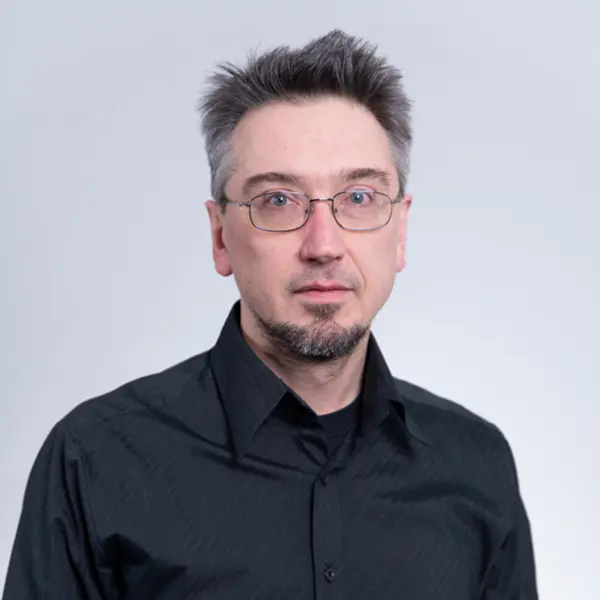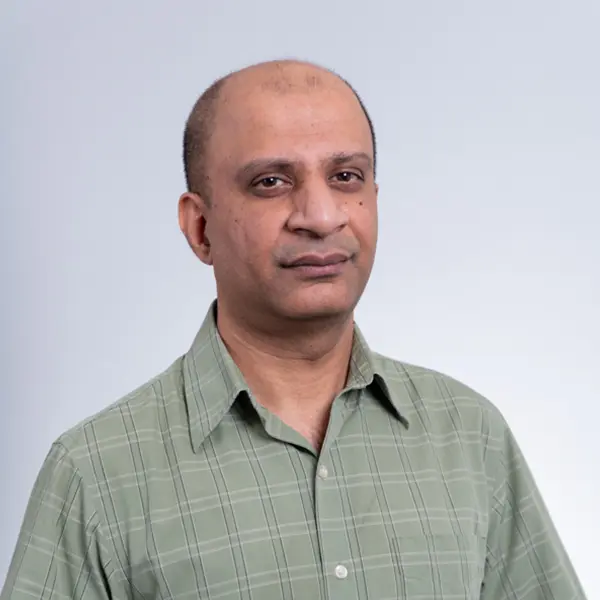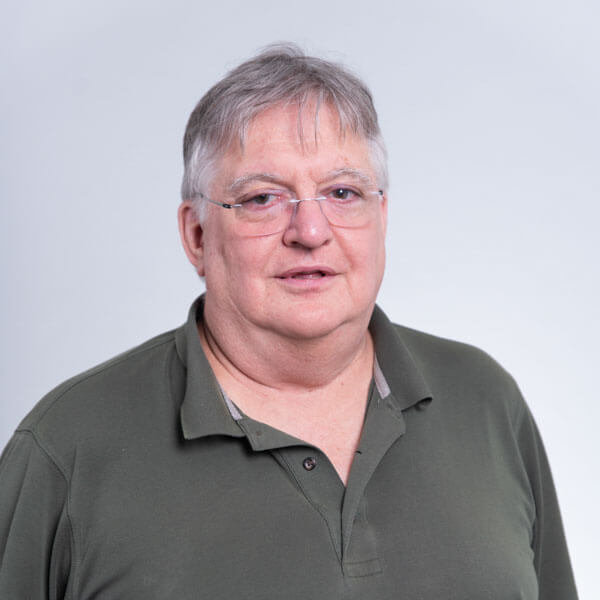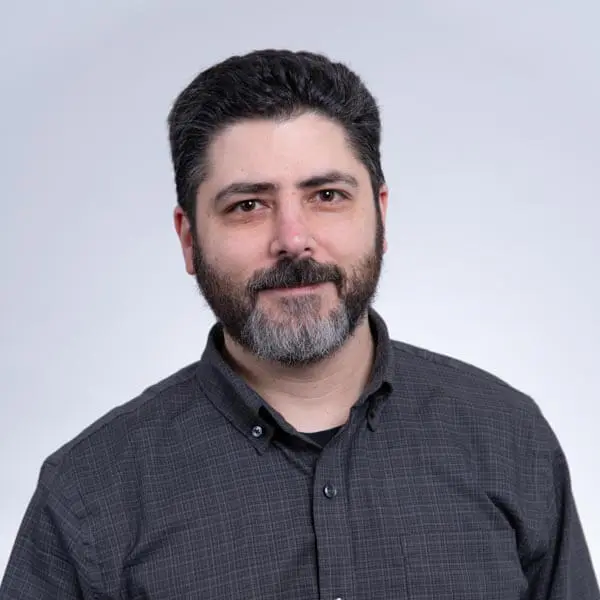Our graduate faculty bring a level of expertise to the classroom with experience ranging from their formal education to their unique specializations in research topics. Faculty leading our MS in Computer Science program use their skillsets in data science, machine learning, and more to inform their teaching styles on both core computer science essentials and the latest advancements in tech, like artificial intelligence. While some faculty come with industry experience having worked at major tech studios like Electronic Arts and Nintendo, others draw their strengths from their academic tenures at previous institutions and their own education journeys.
MS in Computer Science Faculty

Dmitri Volper, Ph.D.
Ph.D. in Mathematics from Novosibirsk State University
Specializations: Algorithm analysis, Efficient programming, Parallel and distributed computing
Dmitri Volper has a Ph.D. in Mathematics from Novosibirsk State University in Russia. Before joining DigiPen in 2006, Volper taught at Omsk State University and SUNY Geneseo. At DigiPen, Volper teaches Advanced C++, Artificial Intelligence, and Design and Analysis of Algorithms, focusing on the fundamentals of clear and efficient programming.
Dmitri Volper has a Ph.D. in Mathematics from Novosibirsk State University in Russia. Before joining DigiPen in 2006, Volper taught at Omsk State University and SUNY Geneseo.
At DigiPen, Volper teaches Advanced C++, Artificial Intelligence, and Design and Analysis of Algorithms, focusing on the fundamentals of clear and efficient programming. Volper has also been actively involved in developing the Master of Science in Computer Science curriculum, supervising master’s theses, and providing academic guidance to graduate students. In addition to his academic roles, Volper coaches the ACM programming competition club.
Selected Publications
- Abhishek Chawan and Dmitri Volper, “Wall-Building in RTS Games,” GAMEON-NA 2008, August 13-15, 2008, McGill University, Montreal, Canada.

Ola Amayri, Ph.D.
Ph.D. in Electrical and Computer Engineering from Concordia University
Specializations: Machine Learning, Data Science, Text Classification, Statistical Models
Dr. Amayri earned her doctorate in Electrical & Computer Engineering and master’s degree in Information Systems Security from Concordia University in Montreal, where she worked on statistical models, text classification, and machine learning. Of note, her machine learning research in spam filtering received attention from media outlets all across the world.
Dr. Amayri earned her doctorate in Electrical & Computer Engineering and master’s degree in Information Systems Security from Concordia University in Montreal, where she worked on statistical models, text classification, and machine learning. Of note, her machine learning research in spam filtering received attention from media outlets all across the world.
Prior to teaching at DigiPen, she was a postdoctoral fellow at École de technologie supérieure (ÉTS) in Montreal. Her postdoc included working on different research projects for the Smart Cities initiative, where her machine learning algorithms were developed and applied.

Xin Li, Ph.D.
Ph.D. in Computer Science from the University of Central Florida
Specializations: Real-Time Rendering Techniques, Computer Graphics, Animation and Modeling Algorithms
Dr. Li is the former Dean of Faculty, having served in that capacity at DigiPen’s Redmond and Singapore campuses. Aside from his academic and administrative duties, he has also taught animation, modeling, and real-time rendering techniques.
Dr. Li is the former Dean of Faculty, having served in that capacity at DigiPen’s Redmond and Singapore campuses. Aside from his academic and administrative duties, he has also taught animation, modeling, and real-time rendering techniques.
Prior to his faculty position at DigiPen, Li had seven years of experience with Lockheed Martin and three years of experience at Nintendo Software Technology, developing real-time simulation software and video games.
Over the years, Li has published 35 technical papers in research journals and conference proceedings, including at SIGGRAPH and in Transactions, the Association for Computing Machinery’s (ACM) academic journal. He is also the co-author of eight registered U.S. patents.

Pushpak Karnick, Ph.D.
Ph.D. in Computer Science from Arizona State University
Specializations: Computer Vision, Machine Learning, Procedural Modeling, Geospatial Visualization
Dr. Karnick received his Ph.D. in Computer Science from Arizona State University, in 2009. His areas of specialization were Procedural Modeling and Geospatial Visualization. His prior experience, academic and industrial, includes system and software development in the areas of VLSI Testchip compilers and visualization tools, Virtual Reality installations, and 3-dimensional geometric tools for domain scientists.
Dr. Karnick received his Ph.D. in Computer Science from Arizona State University, in 2009. His areas of specialization were Procedural Modeling and Geospatial Visualization. His prior experience, academic and industrial, includes system and software development in the areas of VLSI Testchip compilers and visualization tools, Virtual Reality installations, and 3-dimensional geometric tools for domain scientists.
Since 2010, Dr. Karnick has taught a wide spectrum of courses in the areas of Computer Graphics, Image Processing and Computer Vision, Artificial Intelligence, and Software Engineering. He collaborates with students from the MSCS program at DigiPen to pursue research in the above areas.
Selected Publications
- Myers C. and Karnick P., “Distance-based Construction Behaviors for Dynamic Grid-Based Worlds,” Proceedings of the Second Workshop on Artificial Intelligence in Game Design Process, 2013, Boston, USA.
- Karnick P., Cline D., Jeschke S., Razdan A., and Wonka P., “Route Visualization Using Detail Lenses,” IEEE Transactions on Visualization and Computer Graphics, 16 (2), pp. 235 - 247, 2010.
- Karnick P., Jeschke S., Cline D., Razdan A., Wentz E., and Wonka P., “A Shape Grammar for Developing Glyph-Based Visualizations,” Computer Graphics Forum, 28 (8), pp. 2176 - 2188, 2010.
- Amresh A. and Karnick P., “Creating Interest in Computer Graphics by Teaching Game Development,” Proceedings of Eurographics Conference 2007, EG Education Papers, Eurographics Association, pp. 9 - 16, 2007, Prague, CZ.

Jason Hanson, Ph.D.
Ph.D. in Mathematics from the University of Hawaii
Specializations: Algebraic and Computational Topology, Data Structures, Algorithm Analysis, Sound Synthesis
Dr. Hanson earned his doctorate in mathematics from the University of Hawaii, where he studied algebraic topology. He also holds a master’s degree in physics from the University of Virginia, as well as an undergraduate degree in astronomy from the University of Massachusetts. Prior to teaching at DigiPen, Dr. Hanson taught at U.S. military bases in South Korea for the University of Maryland. His non-academic experience includes working as a computer programmer at NASA GISS in New York.
Dr. Hanson earned his doctorate in mathematics from the University of Hawaii, where he studied algebraic topology. He also holds a master’s degree in physics from the University of Virginia, as well as an undergraduate degree in astronomy from the University of Massachusetts. Prior to teaching at DigiPen, Dr. Hanson taught at U.S. military bases in South Korea for the University of Maryland. His non-academic experience includes working as a computer programmer at NASA GISS in New York.
Since coming to DigiPen in 2000, Dr. Hanson has taught a wide variety of classes in both the Computer Science and Mathematics departments, including calculus, programming, data structures, algorithm analysis, computer graphics, data compression, sound synthesis, and animation techniques.
Selected Publications
- Dovermann, K.H., Hanson, J., and Little, R.D., “Examples of Algebraically Realized Maps,” Geometriae Dedicata, 186: 1, 2017.
- Hanson, Jason, “Orthogonal Decomposition of Lorentz Transformations,” General Relativity and Gravitation, 45:599, 2013.
- Aristidou, Michael and Hanson, Jason, “Logarithm of the Discrete Fourier Transform,” International Journal of Mathematics and Mathematical Sciences, vol. 2007, Article ID 20682, 3 pages, 2007.
- Hanson, J. and Dovermann K. H., “Tensor Products of Symmetric Functions over Z2,” Central European Journal of Mathematics 3, no. 2, 2005.

Matt Klassen, Ph.D.
Ph.D. in Mathematics from the University of Arizona
Specializations: Geometric Spline Modeling, Digital Signal Processing, Combinatorial Game Theory, Quantum Algorithms
Dr. Matt Klassen earned his Ph.D. in mathematics from the University of Arizona in 1993, specializing in number theory and algebraic geometry. Since joining DigiPen in 1999, his interests moved to mathematics relating to computer graphics and geometric modeling with particular emphasis on splines. He went on to develop special courses on quaternions with application to computer graphics and animation, and spline curves through the perspective of linear algebra.
Dr. Matt Klassen earned his Ph.D. in mathematics from the University of Arizona in 1993, specializing in number theory and algebraic geometry. Since joining DigiPen in 1999, his interests moved to mathematics relating to computer graphics and geometric modeling with particular emphasis on splines. He went on to develop special courses on quaternions with application to computer graphics and animation, and spline curves through the perspective of linear algebra. Some of this course work led to a paper: “Generalized Vandermonde Determinants and Splines,” presented at a conference in honor of Peter Borwein, May 2008, at Simon Fraser University.
Klassen also developed an interest in combinatorial game theory and has been teaching a course in the subject which is attended by undergraduate and graduate students in computer science. At least one graduate student chose to do a masters thesis in this area under the supervision of professor Klassen, entitled “Solving the 4x3x3 Three Dimensional Domineering Game.”
Relating more to his original studies in geometry and number theory, Klassen explored non-associative structures on curves, which led to a paper presentation: “Non-Associative Loops on Fermat Curves of Odd Degree,” Summer Workshop on Computational Number Theory, IRMACS Center, Simon Fraser University, September 2009.
In 2011, Dr. Klassen laid the groundwork for two new programs at DigiPen, requested by President Claude Comair: the BA in Music and Sound Design, and the BS in Computer Science in Digital Audio (originally BS in Engineering and Sound Design). He has taught courses in Mathematics of Music (for the BA program), and in Digital Signal Processing (for the BS program). In spring semester 2018, Klassen will teach a special topics course on “Computation and Modeling of Head-Related Transfer Functions,” which will explore methods of spatial sound processing with applications for virtual and augmented reality. This course precedes an international conference in August 2018 called “Audio for Virtual and Augmented Reality,” hosted by DigiPen. The conference is chaired by Klassen, and jointly organized by DigiPen and Dr. Edgar Choueiri at Princeton University 3D3A Lab.
“DigiPen provides a dynamic context for teaching and learning mathematics,” Klassen says. “Students are highly motivated and generally appreciate the power of mathematics, which shows up in their project work in signal processing, graphics and game development.”

Anand Thirumalai, Ph.D.
Ph.D. in Physics from The University of British Columbia
Specializations: Stellar Winds, Computational Atomic and Molecular Structure in Astrophysics
Anand Thirumalai earned his bachelor’s degree in materials engineering from the Indian Institute of Technology (IIT) in Roorkee, India. He then went on to earn a master’s degree in materials engineering from the University of British Columbia (UBC). For his master’s thesis he worked on designing and characterizing new-generation turbine blade materials, made of nickel-based superalloys.
Anand Thirumalai earned his bachelor’s degree in materials engineering from the Indian Institute of Technology (IIT) in Roorkee, India. He then went on to earn a master’s degree in materials engineering from the University of British Columbia (UBC). For his master’s thesis he worked on designing and characterizing new-generation turbine blade materials, made of nickel-based superalloys.
After getting his master’s degree, he switched fields completely to follow his passion and scientific curiosity — astrophysics. For his second master’s degree at UBC, this time in astrophysics, he worked on studying the strongest magnetic fields in the known universe — those found in neutron stars — and computing the structure of atoms in such field strengths.
Later, his Ph.D. work looked at the end stages of stellar evolution. He developed a novel stellar wind model combining magnetohydrodynamics with particulate dust-dynamics and stellar rotation. His wind model is applicable to a range of stellar masses and stellar sub-types and presents a route for solving the so-called missing mass-loss mechanism problem in certain types of evolved stars.
Before coming to DigiPen, Dr. Thirumalai was also a School of Earth and Space Exploration Postdoctoral Fellow at Arizona State University. His research there involved studying winds of evolved stars as well as research in computational atomic structure. He has developed some of the fastest and most accurate atomic structure software for atoms in strong magnetic fields. He continues this research work in collaboration with researchers at UBC in Vancouver, as well as with researchers at the University of Oslo in Norway. His research these days focuses on making headway in the almost completely uncharted field of atomic and molecular structure in strong magnetic fields, as well simulations of star and planet formation. A large part of his current research focus involves harnessing the immense computing power of GPUs in astrophysical simulations.
Dr. Thirumalai teaches at all levels of the physics curriculum at DigiPen and believes in promoting diversity and inclusivity in the classroom, placing an emphasis on both teamwork as well as an interdisciplinary approach for solving modern problems using modern methods of solution.
Selected Publications
- Thirumalai, A., Desch, S. J., and Young, P., “Carbon atom in intense magnetic fields,”. Physical Review A, 90, 052501 (2014).
- Anand Thirumalai and Jeremy S. Heyl, “Energy levels of light atoms in strong magnetic fields,” Invited review article in Advances in Atomic, Molecular and Optical Physics, Vol. 63, Chapter 5, p. 323 (2014).
- Anand Thirumalai and Jeremy S. Heyl, “Two-dimensional pseudospectral Hartree-Fock method for low-Z atoms in intense magnetic fields,” Physical Review A, 89, 052522 (2014).
- Anand Thirumalai and Jeremy S. Heyl, “Is Mira a magneto-dusty rotator?” Monthly Notices of the Royal Astronomical Society, Vol. 430, p. 1359 (2013).
- Anand Thirumalai and Jeremy S. Heyl, “The magnetised bellows of Betelgeuse,” Monthly Notices of the Royal Astronomical Society, Vol. 422, p. 1272 (2012).
- Anand Thirumalai and Jeremy S. Heyl, “A hybrid steady-state magnetohydrodynamic dust-driven stellar wind model for AGB stars,” Monthly Notices of the Royal Astronomical Society, Volume 409, p. 1669 (2010).
- Anand Thirumalai and Jeremy S. Heyl, “Hydrogen and helium atoms in strong magnetic fields,” Physical Review A, vol. 79, 012514 (2009).

Gary Herron, Ph.D.
Ph.D. in Mathematics from the University of Utah
Specializations: Geometric Modeling, Computer Graphics
Dr. Herron received his Ph.D. in Mathematics from the University of Utah, in 1979. His particular fields of study were Geometric Modeling and Computer Graphics. Since then, he has spent nearly 40 years working in those fields, in both academic and industrial settings. In academia, he conducted a research program that produced about 20 refereed papers, movies, and conference presentations, along with a number of master’s students, and a Ph.D. student.
Dr. Herron received his Ph.D. in Mathematics from the University of Utah, in 1979. His particular fields of study were Geometric Modeling and Computer Graphics. Since then, he has spent nearly 40 years working in those fields, in both academic and industrial settings. In academia, he conducted a research program that produced about 20 refereed papers, movies, and conference presentations, along with a number of master’s students, and a Ph.D. student. In industry, he worked for Applied Geometry / Alias|Wavefront / SGI producing the surface and curve software libraries that form the mathematical basis for several geometric modeling and design systems.
Since coming to Digipen in 2003, Dr. Herron has taught a wide range of Computer Graphics courses from sophomore through graduate student levels.

Steve Rabin
MS in Computer Science from the University of Washington
Specializations: AI, Data Visualization, Code Optimization
Steve Rabin earned a BS in Computer Engineering and an MS in Computer Science, both from the University of Washington. He lectured on game AI at the University of Washington for seven years and has been a principal lecturer at DigiPen since 2006, teaching undergraduate and masters-level game AI and data visualization courses.
Steve Rabin earned a BS in Computer Engineering and an MS in Computer Science, both from the University of Washington. He lectured on game AI at the University of Washington for seven years and has been a principal lecturer at DigiPen since 2006, teaching undergraduate and masters-level game AI and data visualization courses.
Currently, Rabin is a principal software engineer at Nintendo Technology Development, where he researches new techniques for Nintendo’s current and future platforms, architects development tools such as the Nintendo CPU Profiler, and manages UX on Nintendo’s game development tools. Rabin holds 15 Nintendo-issued patents on data collection/analysis/visualization, Augmented Reality, and the Wii Remote. He has contributed to Nintendo’s NES, SNES, Game Boy, GameCube, DS, Wii, Wii U, 3DS, and Switch platforms, having worked at Nintendo for over 20 years. Before Nintendo, Rabin worked primarily as an AI engineer at several Seattle startups, including Gas Powered Games, WizBang! Software Productions, and Surreal Software.
Rabin has been a key figure in the game AI community for over 20 years, having organized and edited publications such as the Game AI Pro series, AI Game Programming Wisdom series, and Introduction to Game Development. He has also contributed as a writer to over 20 books on game development, including the Game Programming Gems series. Rabin has been an invited keynote speaker at several academic AI conferences, founded the AI Game Programmers Guild in 2008 (now including over 650 professional members worldwide), and founded the 2-day AI Summit at the annual Game Developers Conference (GDC), where he has been a summit advisor since 2009.
Selected Publications
- S. Rabin and N. Sturtevant, “Combining Bounding Boxes and JPS to Prune Grid Pathfinding,” AAAI Conference on Artificial Intelligence, 2016.
- N. Sturtevant and S. Rabin, “Canonical Orderings on Grids,” International Joint Conference on Artificial Intelligence (IJCAI), 2016.
Selected Game Credits
- Dungeon Siege, Microsoft (PC, 2002)
- Microsoft Baseball 3D, Micosoft (PC, 2000)
- HyperBlade, Activision (PC, 1998)